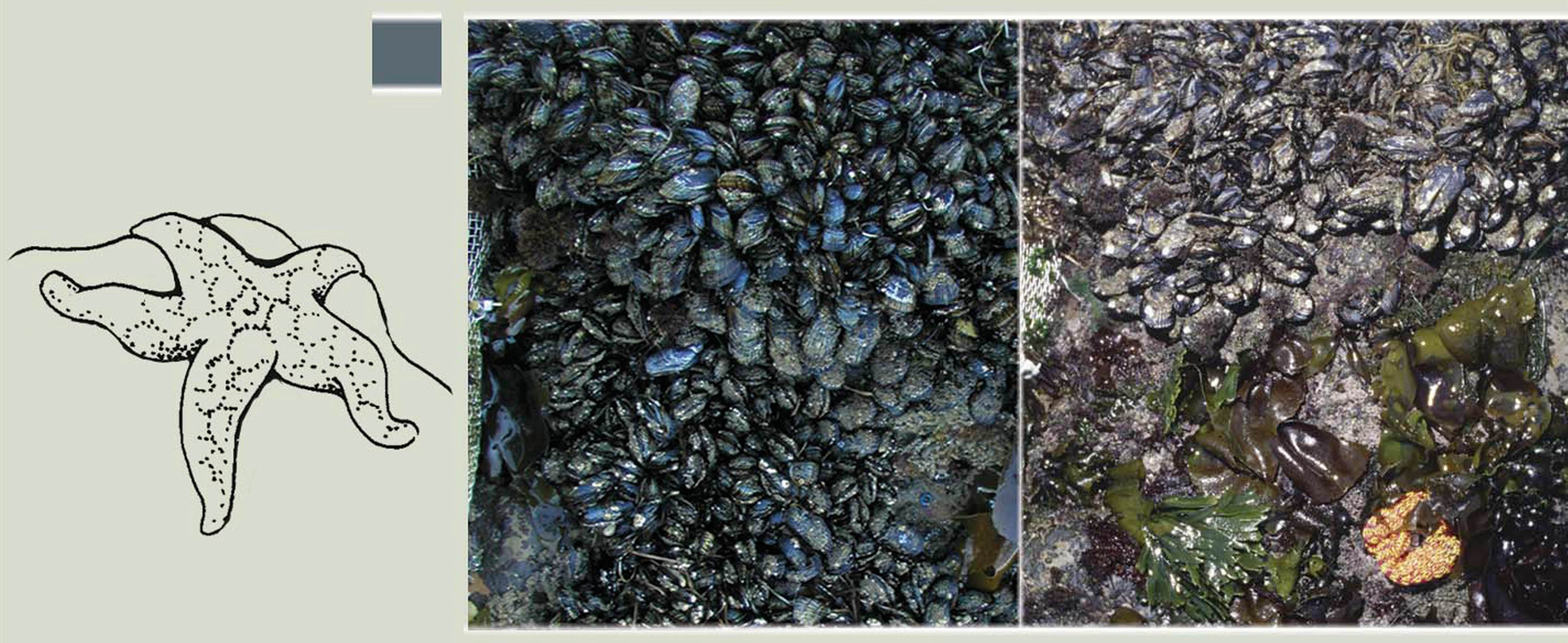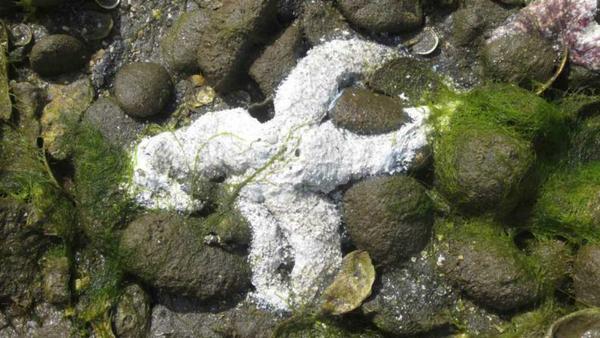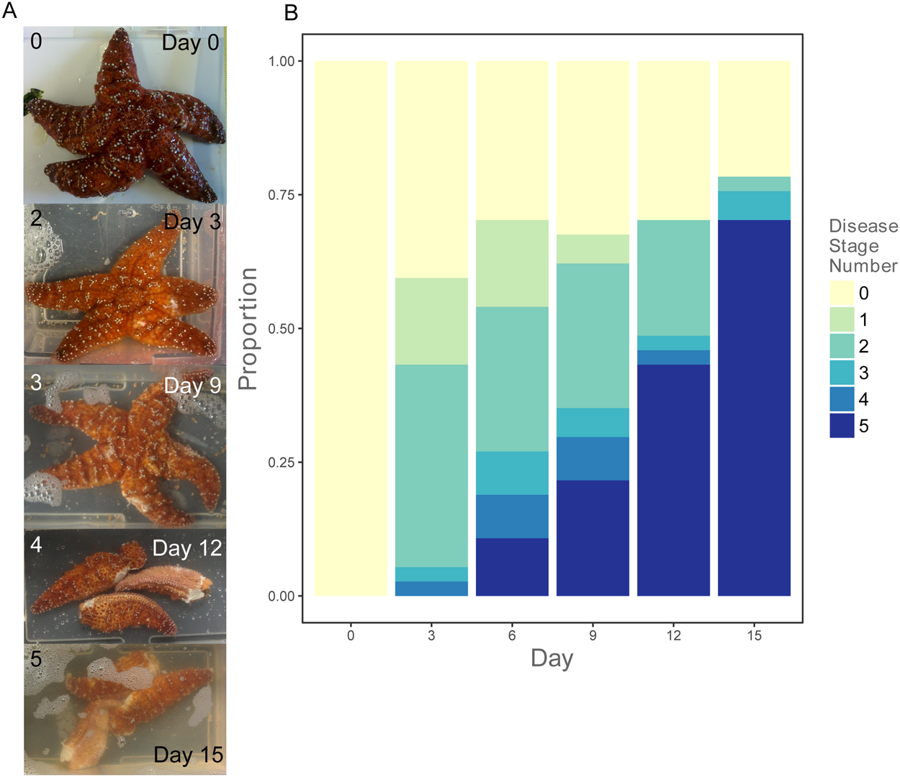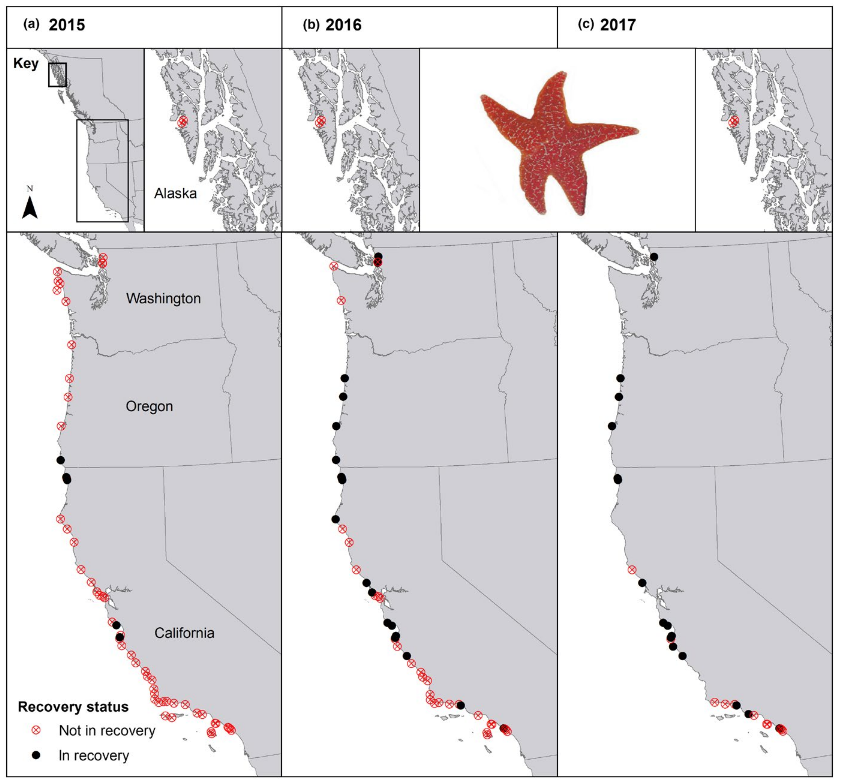By: Dana Sackett
A sea star is not usually the first example that comes to mind when picturing a voracious and fearsome top predator. However, many sea stars, the star-shaped echinoderms colloquially called “starfish” and often found in beach-motif decor, are just that: awesome top predators. Moreover, many sea star species are keystone species, or species that have a major impact on the diversity and functioning of their ecosystem. For instance, the sunflower sea star can grow to over 3ft (~1m) and move more than a meter per minute devouring everything in its path, particularly sea urchins and even fish.

The most well-known keystone sea star is the purple or orchre sea star. Scientists discovered that removing the purple sea star from their coastal intertidal habitat allows mussel populations to quickly cover these rocky habitats; the mussels in turn prevent other species from establishing themselves. Similarly, sea stars that prey primarily on sea urchins keep those populations from growing out-of-control and mowing down giant kelp forests that provide food and refuge to numerous aquatic species. Thus, a population of sea stars has important indirect impacts on many species throughout an ecosystem. Also because of their importance, many scientists quickly became alarmed when these top predators began disappearing a few year ago.

Starting in 2013, sea stars started dying off in droves of a gruesome disease called sea star wasting disease (SSWD). The grisly symptoms start with white lesions that lead to a deflated body, slackening heartbeat, limbs falling off, ruptured organs, and death. While this disease has been seen in the past, it had never caused death so quickly, occurred at such a large scale, or occurred for as long as was seen between 2013 and 2015 (now called the Northeast Pacific SSWD event).

During this time more than 20 species of sea stars from Mexico to Alaska were severely impacted. The sunflower sea star was particularly susceptible with 80% to 100% population declines occurring within its ~3000 km range (from California to Alaska in shallow and deep offshore habitats). On the east coast of the United States sea star wasting disease impacted coastal waters from New Jersey to New England also.

The cause of this disease was a mystery until 2014 when researchers were able to link the densovirus to the disease. The pathway and hosts of the disease are still being discovered. One link that researchers have found is that unusually warm waters exacerbate the disease: causing a higher risk of infection and faster progression to death. This was not the first time warmer sea temperatures have been seen to influence the prevalence and severity of marine infectious diseases. However, it was the first time that those unusually warmer temperatures were found to be a key facilitator of such widespread disease-related deaths.

Sea Star Wasting Disease progression through a two-week experiment. (A) Photographs taken from one purple sea star as it progressed through the disease. (B) Proportion of the 37 individuals of each symptom number at the six sampling time points. Source Lloyd and Pespeni 2018:
The disease itself and secondary consequences of such a dramatic loss of so many top predators are still ongoing. For instance, with the demise of sunflower sea stars, sea urchin populations have exploded in some areas, substantially reducing kelp forests and the fish and fisheries that rely on them.

Scientists are using this extreme event to learn about evolution. With an average of 81% of the purple sea stars dying across populations within their range, researchers were able to compare the genetic variation of these populations before the disease occurred to the survivors. They found that the survivors had disease resistant traits and that those traits were passed on to their offspring. Thus, natural selection shaped the surviving population and the new generation of purple sea stars.

While it is promising to see that at least one species of sea star may recover with some resistance to this deadly disease there are still too many other factors that could affect this species to truly know how they will fare in the years to come. Another study recently found that while purple sea stars are recovering within their range, more time is needed before these populations are able to resume their role as keystone predators in their ecosystems.
References and other resources:
See our previous article for more information on keystone species here and on how the loss of a species can impact an ecosystem here
Harvell CD, Montecino-Latorre D, Caldwell JM, Burt JM, Bosley K, Keller A, et al. 2019. Disease epidemic and a marine heat wave are associated with the continental-scale collapse of a pivotal predator (Pycnopodia helianthoides). Science Advances 5: eaau7042: DOI: 10.1126/sciadv.aau7042.
Hewson I, Button JB, Gudenkauf BM, Miner B, Newton AL, Gaydos JK, et al. 2014. Denovirus associated with sea-star wasting disease and mass mortality. PNAS www.pnas.org/cgi/doi/10.1073/pnas.1416625111.
Lloyd MM, Pespeni MH. 2018. Microbiome shifts with onset and progression of sea star wasting disease revealed through time course sampling. Scientific Reports 8:16476. https://doi.org/10.1038/s41598-018-34697-w
Miner CM, Burnaford JL, Ambrose RF, Antrim L, Bohlmann H, Blanchette CA, et al. 2018. Large-scale impacts of sea star wasting disease (SSWD) on intertidal sea stars and implications for recovery. PLoS ONE 13(3): e0192870. https://doi.org/10.1371/journal.pone.0192870.
Moritsch MM, Raimondi PT. 2018. Reduction and recovery of keystone predation pressure after disease-related mass mortality. Ecology and Evolution 8:3952-3964.
Schiebelhut LM, Puritz JB, Dawson MN. 2018. Decimation by sea star wasting disease and rapid genetic change in a keystone species, Pisaster ochraceus. PNAS 115:7069-7074. http://www.pnas.org/cgi/doi/10.1073/pnas.1800285115
Stokstad E. 2014. Death of the Stars. Science 344:464-467.
University of California – Davis. “Once-abundant sea stars imperiled by disease along West Coast: Some of ocean’s biggest stars affected by disease and climate change.” ScienceDaily. ScienceDaily, 30 January 2019. <www.sciencedaily.com/releases/2019/01/190130161646.htm>.
